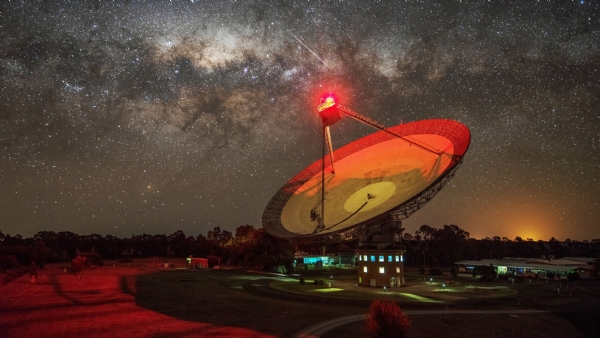Indian astronomer captures 8 billion old radio signal from space
The details published in the Monthly Notices of the Royal Astronomical Society state that understanding the evolution of galaxies over cosmic time requires knowledge of the cosmic evolution of the neutral gas, which is hydrogen. The signal was detected from a distant star-forming galaxy known as SDSSJ0826+5630 and measured its gas composition.
Total Views |
New Delhi, January 20: Astronomers from India and Montreal have captured a radio signal from the most distant galaxy at a specific wavelength of 21 cm line to peer into the secrets of the early universe. They used the Giant Metrewave Radio Telescope in India to detect this type of radio signal at such a large distance.
Researchers from across the world are involved in detecting such signals to look at what happened in the early universe. However, it has been difficult for telescopes on Earth to pick up these radio signals since they become weaker the further away a galaxy is from Earth.
Researchers from across the world are involved in detecting such signals to look at what happened in the early universe. However, it has been difficult for telescopes on Earth to pick up these radio signals since they become weaker the further away a galaxy is from Earth.

The details published in the Monthly Notices of the Royal Astronomical Society state that understanding the evolution of galaxies over cosmic time requires knowledge of the cosmic evolution of the neutral gas, which is hydrogen. The signal was detected from a distant star-forming galaxy known as SDSSJ0826+5630 and measured its gas composition.
Arnab Chakraborty, a Post-Doctoral Researcher at McGill University, who led the study said, “A galaxy emits different kinds of radio signals. Until now, it’s only been possible to capture this particular signal from a galaxy nearby, limiting our knowledge to those galaxies closer to Earth."
First Radio Signal From an Exoplanet Detected By Scientistshttps://t.co/ui0hn0BySk
— Amazing Astronomy (@MAstronomers) January 14, 2023
Using the #GMRT, astronomers from @McGillUPhysics & @Physics_at_IISc, have detected a radio signal due to atomic hydrogen in a distant galaxy. The galaxy is so far away that even light takes 8.8 billion years to reach us! (1/2)https://t.co/vlxeD5B4ZK#21cm #gravitationallens pic.twitter.com/tcyGkIaEv2
— National Centre for Radio Astrophysics (@NCRA_Outreach) January 17, 2023
He added that thanks to the help of a naturally occurring phenomenon called gravitational lensing, they could capture a faint signal from a record-breaking distance. The signal will help them understand the composition of galaxies at much greater distances from Earth.
The team of researchers observed the atomic mass of the hydrogen gas content of this particular galaxy which is almost twice the mass of the stars visible to us. The signal was emitted from this galaxy when the universe was only 4.9 billion years old, enabling the researchers to glimpse into the secrets of the early universe. The universe is 13.6 billion years old.
"Astronomers from @mcgillu and @iiscbangalore have used data from the Giant Metrewave Radio Telescope (GMRT) in Pune to detect a radio signal originating from atomic hydrogen in an extremely distant galaxy."https://t.co/pMfzLucHdf @NCRA_Outreach
— Amit Paranjape (@aparanjape) January 16, 2023
“It’s the equivalent to a look-back in time of 8.8 billion years,” says Chakraborty, who studies cosmology at McGill’s Department of Physics.
The signal would have never been picked had it not been magnified by gravitational lensing In this specific case, the signal was bent by the presence of another massive body, another galaxy, between the target and the observer. This resulted in the magnification of the signal by a factor of 30, allowing the telescope to pick it up.
Also Read | India's Chandra telescope captures comet that last came to Earth 50,000 years ago
Researchers said that these results demonstrate the feasibility of observing faraway galaxies in similar situations with gravitational lensing. It also opens exciting new opportunities for probing the cosmic evolution of stars and galaxies with existing low-frequency radio telescopes.
Researchers said that these results demonstrate the feasibility of observing faraway galaxies in similar situations with gravitational lensing. It also opens exciting new opportunities for probing the cosmic evolution of stars and galaxies with existing low-frequency radio telescopes.

